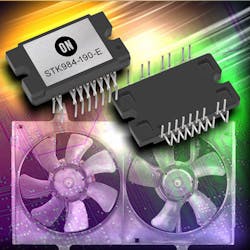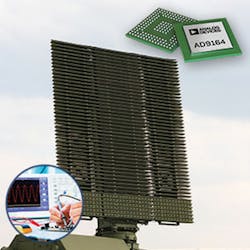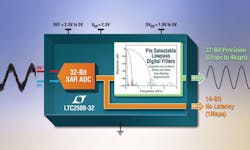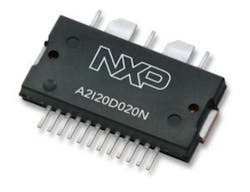Semiconductor Product Focus: Chip and power-device makers offer diversity
emiConsolidation has been the trend among chipmakers and power-device makers. Analog Devices and Linear Technology announced in July they have entered into a definitive agreement under which Analog Devices will acquire Linear Technology. Analog says that the cash and stock transaction values the combined company at approximately $30 billion. The acquisition is expected to close by the end of the first half of calendar year 2017.
Also in July, Cree announced execution of a definitive agreement to sell its Wolfspeed Power and RF division, which includes the silicon carbide substrate business for power, RF, and gemstone applications, to Infineon Technologies for $850 million in cash. Wolfspeed brings its GaN HEMT devices to chipmaker Infineon, and Cree will concentrate on its strategy to become a more focused LED lighting company.
And in May, Microchip Technology and Micrel announced that Microchip had signed a definitive agreement to acquire Micrel. These moves complemented earlier ones, such as the merger of NXP and Freescale (with the company now known as NXP) and the combination of RFMD and Triquint to form Qorvo. But although companies may be consolidating, their offerings remain diverse as the sampling below indicates.
The AD9164 D/A converter handles high-resolution radar images for designers of military and commercial radar while reducing solution component count. In addition, for designers of precision instrumentation equipment, such as smartphone testers, the new device ensures improved accuracy as well as speed of test, contributing to faster market-ready time while decreasing tester complexity and size. Thanks to its audio to 6-GHz frequency coverage, the AD9164 D/A converter moves the tester market one step closer to a universal wireless test platform.
The reduction in solution component count and thus size enables element-level digital beamforming advanced radar solutions. With the same performance specifications as the already released AD9162, the AD9164 D/A converter also includes an on-chip direct digital synthesizer that ensures phase-coherent fast frequency hopping of less than 300 ns for up to 32 different frequencies. This makes the AD9164 D/A converter suited for testing anything from the AM broadcast band or the Japanese FM band to the 5.8-GHz UNII band.
The AD9164 converter features a 2x interpolator (FIR85), which enables configurability for lower data rates and converter clocking to reduce overall system power and ease filtering requirements. In mix-mode operation, this D/A converter can be configured to reconstruct RF carriers in the second and third Nyquist zones up to 7.5 GHz while maintaining high dynamic range. The AD9164 also comes with a unique remote evaluation tool allowing designers to “test drive” the D/A converter’s performance. Analog Devices
Thyristor/diode modules
A new 50-mm module extends the vendor’s product portfolio of thyristor/diode modules with solder-bond technology. These bipolar modules address the growing market for cost-effective solutions in demanding applications. Depending on the module, market prices are approximately 25% lower than comparable pressure contact variants. Solder-bond modules are suitable for applications where the high robustness of pressure contact technology is not necessarily a must. Typical applications for the new 50-mm modules are drives, power supplies, and welding equipment.
The new 50-mm variant covers current ratings from 280 A to 330 A. The 20-mm and 34-mm variants have been in production for more than two years and proven their reliability in the field. All modules have been developed as cost- and performance-optimized alternatives to pressure contact technology. They are packaged in industrial standard housings with an electrically insulated base plate. Infineon Technologies
DOCSIS 3.1-ready power doublers
Three new DOCSIS 3.1-ready power doubler multichip modules (MCMs) supply cable broadband service providers an easy upgrade path to DOCSIS 3.1 with maximum design flexibility and functionality while conserving power and reducing board space. The RFCM3327 and RFCM3328 feature the vendor’s GaN-on-SiC process to deliver superior thermal conductivity. The RFCM3327 MCM offers 23 dB gain while the RFCM3328 provides 25 dB gain. Both power doublers are capable of +63 dBmV power output, and both include an external current control feature that allows customers to reduce overall power consumption by up to 20% while meeting required linearity specifications. Qorvo
DC/DC converter
The TPS54A20 SWIFT 8-V to 14-V, 10-A, 10-MHz series-capacitor buck converter achieves more than 50 A/cm3 in current density, which is four times higher than any other 12-V power-management component or solution available today, the vendor reports. The unique topology of the TPS54A20 SWIFT synchronous DC/DC converter enables high-frequency operation at up to 5 MHz per phase without special magnetics or compound semiconductors. By using the step-down converter together with TI’s WEBENCH Power Design tool, engineers can get space- and height-constrained point-of-load telecom and networking power-supply designs to market faster.
The TPS54A20 features a unique two-phase, series-capacitor DC/DC buck topology that merges a switched-capacitor circuit with a multiphase buck converter. This capacitive-conversion technology enables efficient, high-frequency operation and measures as much as seven times smaller than conventional converters. Texas Instruments
Low-power MCUs
Dubbed the vendor’s lowest power and most cost-effective 32-bit PIC32 microcontrollers (MCUs), the PIC32MM family bridges the gap between the company’s PIC24F XLP and
PIC32MX families. The new family is the first PIC32 to feature core-independent peripherals designed to offload the CPU for lower power and lower system design. The PIC32MM devices are supported by the vendor’s MPLAB Code Configurator to help simplify and accelerate designs.
The family targets IoT, consumer, industrial-control, and motor-control applications that require flexible MCUs that consume less power, are more cost-effective, and have smaller form factors. For applications demanding low power and longer battery life, the PIC32MM has sleep modes down to 500 nA. Applications with space constraints will benefit from the small 4 x 4-mm package options. The PIC32MM devices include core independent peripherals such as configurable logic cells and multiple-output capture compare PWMs which help enable sensorless BLDC motor-control applications. Microchip Technology
32-Bit SAR ADC
The LTC2508-32 ultrahigh-precision 32-bit successive approximation register analog-to-digital converter serves high-performance applications, including data acquisition, industrial control, and medical instrumentation, that require both accuracy and speed. High performance often is achieved using a high-resolution delta-sigma ADC and a high-speed SAR ADC in the same system. The LTC2508-32 simplifies such hybrid ADC system design by simultaneously providing both a 32-bit low noise digitally filtered output and a 14-bit, 1-MS/s no-latency output. Since these outputs are generated from a single 32-bit SAR ADC core, the high-accuracy and high-speed outputs are perfectly matched, even as the operating temperature, supply, and stress vary. In contrast to traditional solutions employing two distinct unmatched ADCs, the unique combination of both accuracy and speed in the LTC2508-32 enables much higher system performance while reducing solution size and lowering component count.
Eight new devices constitute what the vendor calls the industry’s largest portfolio of broadband 28-V LDMOS two-stage, dual-path Doherty-optimized ICs for small-cell base stations. The new LDMOS ICs are designed to provide RF power, efficiency, and gain in all current and proposed frequency bands with RF output power of 2.5 to 12 W. The eight new LDMOS ICs combine two stages of gain for both the carrier and peaking stages required by Doherty power amplifiers in a single device. The four symmetric devices offer ultra wideband performance, up to 900 MHz of RF bandwidth, and 365 MHz of instantaneous bandwidth. The family of asymmetric products covers the full range of frequencies from 700 to 3,800 MHz. All are easy to linearize with analog and digital predistortion solutions.
Broadband symmetric power amplifier ICs include the A2I20D020N (pictured), which covers 1,400 to 2,300 MHz with average RF output power of 2.5 W, gain up to 29.7 dB, and efficiency up to 43% in a TO-270WB-17 plastic package. Reference designs and evaluation boards are available for all eight LDMOS ICs. NXP
The STK984-190-E, optimized for driving three-phase brushless DC motors in modern automotive applications, contains six 40-V, 30-A MOSFETs configured as a three-phase bridge with an additional 40-V, 30-A high-side reverse battery protection MOSFET. The MOSFETs are mounted onto a direct bonded copper (DBC) substrate, resulting in a compact module with excellent thermal performance taking up only half of the board space used by an equivalent discrete solution.
The module is suitable for use in 12-V automotive electric motor drive applications with power ratings up to 300 W, such as electric pumps, fans, and windscreen wipers. The DBC substrate reduces the thermal resistance, which reduces the operating temperature of the MOSFETs, decreasing power losses and increasing reliability. Reliability also is improved by the isolation provided by the DBC substrate. STK984-190-E has a specified operational temperature range of -40°C to 150°C. The integrated MOSFETs are all AEC-Q101 qualified. The STK984-190-E is supplied in a Pb-free DIP-S3 measuring 29.6 mm x 18.2 mm x 4.3 mm. It is priced at $7.00 per unit in 16-unit quantities. ON Semiconductor
About the Author

Rick Nelson
Contributing Editor
Rick is currently Contributing Technical Editor. He was Executive Editor for EE in 2011-2018. Previously he served on several publications, including EDN and Vision Systems Design, and has received awards for signed editorials from the American Society of Business Publication Editors. He began as a design engineer at General Electric and Litton Industries and earned a BSEE degree from Penn State.




